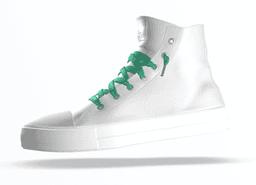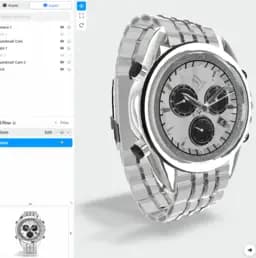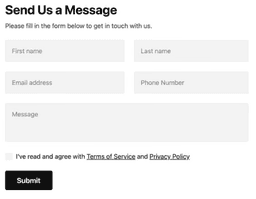Deconstructing WebAR: A Deep Dive into Markers and Tracking
Web AR markers and tracking enable immersive digital experiences in physical environments without necessitating an app download. They work via camera stream, six degrees of freedom, scene understanding, and cloud management systems. Crucially, marker-based AR provides precision using specific markers, while markerless AR offers flexibility sans pre-defined markers.
![]()
The aim of this article is to facilitate a deep understanding of Web AR markers and tracking methodologies, including marker-based and markerless tracking, WebAR image recognition, and implementation insights.
Dissecting WebAR: An Overview of the Concept
Augmented Reality (AR) can be a game-changing technology, especially when it blends seamlessly into the web environment – this innovative amalgamation of AR and web is what’s referred to as WebAR. Unlike traditional AR, where users primarily interact with AR content through dedicated mobile applications, WebAR simplifies this integration by eliminating the need for an app download altogether.
WebAR democratises access to AR experiences remarkably, by reaching out to a larger audience. With broader accessibility and uniformity of experience, WebAR allows audiences to access AR experiences instantaneously. It achieves this feat via a simple URL link, a QR code scan, or a NFC tag tap.

Main Features of WebAR
WebAR comes with a plethora of unique features and capabilities that have redefined how AR is being accessed and consumed today. Among these notable ones include its high accessibility, real-time tracking capabilities, and remarkable compatibility metrics.
High Accessibility
As mentioned earlier, WebAR doesn’t necessitate the craft of a dedicated mobile application to experience AR content. A direct consequence of this is the drastic reduction in accessibility barriers, as WebAR effectively doubles the reach of traditional AR content, reaching almost twice as many mobile users. Instead, audiences can immerse themselves instantaneously in the AR world via a simple browser.
Real-time Tracking
In the realm of WebAR, real-time tracking is a stand-out feature that facilitates efficient object recognition and spatial awareness for accurate AR content projection. It opens up realms of possibilities for marketers to create more engaging and interactive user experiences.
Unparalleled Compatibility
In terms of compatibility, WebAR beats competitors to the punch by supporting all major mobile operating systems. Simply put, whether you’re an Android enthusiast or an iOS loyalist, WebAR is designed to work effectively across all mobile platforms.
- WebAR offers real-time AR experiences right from a web browser without the necessity of a separate AR-specific app download.
- It aims at providing uniform AR experiences by reaching out to a broader audience across all mainstream mobile operating systems.
- WebAR integrates seamless object recognition and tracking capabilities for a more engaging user experience.
![]()
For those seeking in-depth understanding of WebAR and exploration of its potential applications, there are numerous online resources available. One such comprehensive resource is the WebAR tutorial series that covers the foundational WebAR concepts along with hands-on project demonstrations.
WebAR: Where It Stands Now
To summarize, WebAR is more than just another technology buzzword. It’s a ground-breaking revolution in the AR sector which has made AR content more accessible than ever, thanks to its instant immersion capabilities. From retail and real estate to education and entertainment, WebAR is creating waves across industries by providing uniform and readily accessible AR experiences.
| Features | WebAR |
|---|---|
| App Download Needed | No |
| Real-time Tracking | Yes |
| Compatibility | All Major Mobile OS |
Tools of the Trade: Diving into WebAR Frameworks
There are several WebAR frameworks that play a vital role in enhancing the Augmented Reality experience on the web. As these frameworks evolve, they are contributing positively to the seamless and interactive functionalities that embody AR. Let’s delve into some of these popular WebAR frameworks: ARKit, ARCore, AR.js, and Vuforia.

AR.js: An Open Source Solution
AR.js, an open-source framework, stands out in its design, capable of handling up to 60 frames per second (FPS) on both Android and iOS platforms. This advanced performance is driven by the use of marker-based and location-based AR technologies, making AR.js one of the most efficient tools for delivering high-speed, high-quality AR experiences on the web.
As a web developer or an AR enthusiast, you’ll appreciate how AR.js simplifies the development of WebAR projects. The framework allows you to build robust AR applications, which help to drive experimentation and creativity in the industry. With AR.js, developers have the liberty to create, innovate, and push the boundaries of what is possible in WebAR.

Vuforia: User-friendly and Creative
Another significant player in the world of WebAR frameworks is Vuforia. This platform is known for its user-friendliness and the creative freedom it gives to developers. Vuforia’s marker-based AR technology allows for precise and easy tracking, making it particularly useful for developing engaging AR experiences.
One of the standout features of Vuforia is its advanced recognition capabilities. This includes image, text and objects recognition, which allow for a diverse range of AR implementations. Additionally, its minimalistic user interface encourages developers to comfortably utilize the platform, hence fostering creativity in AR experiences.
- AR.js: Best for high-speed, high-quality AR experiences
- Vuforia: Great for creative and diverse AR experiences
If you want to learn more about how the performance of these platforms contribute to the enhancement of WebAR experiences, have a look at these helpful WebAR Performance Techniques.

Other Considerations in WebAR Development
While exploring various WebAR frameworks, it is essential to evaluate factors such as platform capabilities, target audience, and the specific use case. In-depth knowledge of a particular framework accelerates the application development process. However, one also needs to pay keen attention to potential limitations and the required development skills for each platform.
| WebAR Framework | Main Advantages | Potential Limitations |
|---|---|---|
| AR.js | Fast and smooth AR experiences | May have a steep learning curve for beginners |
| Vuforia | Benefits from diverse recognition capabilities | Sometimes limited in spatial awareness |
The realm of WebAR is vast and continuously evolving, where these frameworks only represent a segment of this immense universe. Remember, the chosen framework should align with the conceptual vision and practical needs of the AR project.
Image Recognition and Tracking
Stepping into the realm of WebAR involves a multi-faceted approach, catering to not just one, but several factors which contribute to the overall AR experience. Paramount among these elements are Image Recognition and Tracking. It’s vital that we dive deep into these algorithms to comprehend their role in WebAR. But first, let’s briefly understand how they are intertwined.
A Blend of Sensors, Cameras and Computer Vision
To effectively render digital content in a physical environment, WebAR utilizes a plethora of sensors. These sensors form the backbone of the AR experience, ensuring a seamless interaction between the digital and the real world. The WebAR sensor suite includes camera stream components, six degrees of freedom for digital object placement, scene understanding to interpret the environment, and cloud-based CMS to manage the AR content.

Digging Deeper into Image Recognition and Tracking
Engaging with WebAR entails the use of multiple components, but two key elements working in unison provide its core foundation. These elements are image recognition and tracking; let’s break them down further.
- Image Recognition: This involves identifying and detecting a specific object or feature in a given image or video stream.
- Tracking: After recognition, the system tracks the object’s movement over time, enabling the AR experience to revolve around the moving object seamlessly.
The Role of Computer Vision
A significant part of WebAR image recognition and tracking is underpinned by the technology of computer vision. This field aims to simulate the abilities of human vision in machines with the objective of interpreting and understanding visual data from the real world. In WebAR, computer vision translates the gap between the virtual and the real world.
For a typical WebAR application to work, access to an RGB camera is necessary. Serving as the eyes of the system, it provides perspective and a field of view for the application. The computer vision algorithms run on this visual data, detecting and recognizing markers and subsequently, tracking them in real-time.  Find more detailed principles of Web AR User Interface and User Experience in this comprehensive guide.
Find more detailed principles of Web AR User Interface and User Experience in this comprehensive guide.
Tracking Methods Examined
Moving away from the concept of image recognition, it’s important to explore the specifics of tracking methods within WebAR:
| Mechanism | Description |
|---|---|
| Marker-Based Tracking | Relies on the use of predefined markers that the application identifies and tracks in a scene. |
| Markerless Tracking | Enables the application to track any arbitrary features in the environment that are visually distinguishable. |
| Simultaneous Localization and Mapping (SLAM) | An advanced tracking method that combines object tracking and environment scanning to generate maps of unknown spaces. |
Combining the Puzzle Pieces
When assimilated, these elements constitute the backbone of the WebAR experience. Image recognition lays the groundwork by identifying objects, while tracking ensures the AR content hinges accurately on the object during motion. All this is made possible through advancements in computer vision and processing power, which have given rise to more advanced tracking methods such as SLAM.
Understanding the technology that powers WebAR is vital to its implementation and pushes the boundaries of what is achievable in augmenting our reality.
Marker vs Markerless AR: A Quest for Superiority
Delving deeper into the complexities of Augmented Reality (AR), we’ll examine two different AR technologies crucial in reshaping the landscape of virtual interaction―Marker-based and Markerless AR. Comparing their unique characteristics and advantages, we can understand the application potential within the WebAR realm.
The Distinct Configuration of Marker-based AR
Marker-based AR thrives on the concept of interaction with predefined physical markers. Utilizing these markers, the AR technology triggers virtual overlay, resulting in an enhanced real-world scenario. With these markers, the AR exhibits high precision and stability, further enhancing the user experience with its detailed overlay. 
Advantages of Marker-based AR:
- Accuracy: Offers high precision due to the predetermined positioning of markers.
- Control: Allows full control over AR content and triggers as the markers are predefined.
- Stability: Presents a stable AR view as it doesn’t heavily rely on scene understanding but on marker detection.
The Flexibility of Markerless AR
Don’t want to use predefined markers? That’s where Markerless AR comes into play. This technology relies on algorithms that track and understand the physical world to overlay digitally manipulative enhancements. Detection is based on real-world maps, location services, and other tracking systems. The flexibility and scalability of markerless AR technology make it adaptable and beneficial for various applications.
Advantages of Markerless AR:
- Flexibility: No need for predefined markers, making it flexible.
- Adaptability: Can scale to serve different applications due to its flexible tracking system.
- Real-time Interaction: Engages with user’s environment in real-time, making AR experiences more immersive.
Diving Deeper into Marker-based and Markerless AR
Drawing a detailed comparison between marker-based and markerless AR technologies can provide valuable insights to WebAR developers and enthusiasts pursuing advanced AR experiences.

| Parameter | Marker-based AR | Markerless AR |
|---|---|---|
| Trigger | Predetermined Markers | Real-world Maps, location services |
| Flexibility | Fixed to specific markers | Highly flexible due to lack of markers |
| Applicability | Suitable for specific predefined scenarios | Highly scalable for varying applications |
Interested in crafting responsive AR interfaces? Consider this resourceful guide on creating adaptive and responsive Web AR interfaces, which offers meticulous directives to guide developers in streamlining their AR developments.
The essence of AR lies in its capability to occupy the interface between digital and physical realities. So, understanding the differences, advantages, and applications of marker-based and markerless AR becomes essential in harnessing AR’s potential truly. With a deeper understanding of these technologies, developers can be well-equipped to dive headfirst into building groundbreaking AR experiences targeting broader, diverse audiences.
Bridging Virtual and Reality: Actual Implementations
Augmented Reality (AR) has moved beyond being a mere novelty to serious real-world applications over the years. Powerful frameworks and tracking methodologies have made it possible to converge the virtual and physical worlds seamlessly, thereby transforming several industries, including e-commerce, education, and entertainment. Let’s delve deeper into how WebAR is actively applied in different fields.
Revolutionizing E-commerce with WebAR
E-commerce giants are leveraging the capabilities of marker-based Augmented Reality to enhance the online shopping experience. Utilizing this technology, products can be virtually placed in the user’s environment, thus enabling customers to visualize them more realistically before making a purchase decision. This new visual approach has improved customer engagement and driven higher conversion rates.
One can check out how augmented reality is transforming the online shopping experience on this insightful post about integrating IoT with WebAR applications for enhancing e-commerce.
WebAR in Education
Education is another sector that’s reaping the benefits of WebAR. By implementing 3D object recognition-driven Augmented Reality, education has turned more interactive and engaging. Access to immersive educational content, aided by WebAR, enhances comprehension and retention, making learning an enjoyable experience for students.
- Visualizing complex theories using AR models
- Interactive simulations for practical understandings
- Exploring historical sites and monuments virtually
Revamping Entertainment
Be it movies, gaming, or social media filters, WebAR has been instrumental in taking user immersion to the next level within the entertainment industry. Enhanced interactivity, user engagement, and impressive visual effects have created unique experiences that were once unimaginable.

From multiplayer gaming to interactive streaming platforms, delve deeper into how AR is reshaping the entertainment industry here.
| Industry | WebAR Implementation | Benefits |
|---|---|---|
| Education | Interactive classroom, virtual simulations | Improved comprehension and enhanced student engagement |
| E-commerce | AR Product visualizations | Higher conversion rates, Improved customer engagement |
| Entertainment | AR filters, Immersive gaming | Higher user retention, Unique user experiences |
While these examples offer a glimpse into the potential of WebAR, it is essential to note that the technology holds infinite possibilities across every industry, promising an immersive and interactive future.







